Atrial pacing Study guides, Class notes & Summaries
Looking for the best study guides, study notes and summaries about Atrial pacing? On this page you'll find 2004 study documents about Atrial pacing.
Page 3 out of 2.004 results
Sort by
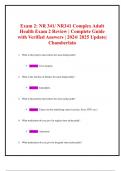
-
Exam 2: NR 341/ NR341 Complex Adult Health Exam 2 Review | Complete Guide with Verified Answers | 2024/ 2025 Update| Chamberlain
- Exam (elaborations) • 21 pages • 2024
-
- $10.99
- + learn more
Exam 2: NR 341/ NR341 Complex Adult Health Exam 2 Review | Complete Guide with Verified Answers | 2024/ 2025 Update| Chamberlain 1. What is the priority intervention for sinus bradycardia? Answer: Give atropine 2. What is the 2nd line of defense for sinus bradycardia? Answer: Epinephrin 3. What is the priority intervention for sinus tachycardia? Answer: Figure out the underlying cause (exercise, fever, HTN, etc.) 4. What medication do you give for regular sinus tachycardi...
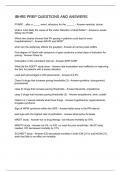
-
IBHRE PREP
- Exam (elaborations) • 41 pages • 2024
-
Available in package deal
-
- $14.49
- + learn more
PVARP....after a _____ event, refractory for the ______ - Answer-ventricle, atrium what is most likely the cause of the under detection of atrial flutter? - Answer-p waves falling into PVAB Which two studies showed that RV pacing in patients could lead to more hospitalizations? - Answer-DAVID and MOST when are the wedensky effects the greatest - Answer-at narrow pulse widths First degree AV block with symptoms of ppm syndrome is what class of indication for pacing - Answer-Class IIa ...

-
BKAT Critical Care Review (2022/2023) Rated A+
- Exam (elaborations) • 12 pages • 2023
- Available in package deal
-
- $9.99
- 2x sold
- + learn more
BKAT Critical Care Review (2022/2023) Rated A+ Normal Central Venous Pressure (CVP) range 2-8 mmHg Normal Pulmonary Artery Occlusion Pressure (PAOP) range 6-12 mmHg Normal Pulmonary Artery Systolic (PAS) range 20-30 mmHg Normal Pulmonary Artery Diastolic (PAD) range 5-15 mmHg Normal Pulmonary Artery Mean (PAM) 11-20 mmHg Normal Systemic Vascular Resistance (SVR) range 800-1200 mmHg Preload volume left in the left ventricle at the end of diastole What is preload affected by? venous return ...
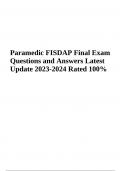
-
Paramedic FISDAP Final Exam Questions and Answers - Latest Update 2023/2024 (GRADED)
- Exam (elaborations) • 21 pages • 2023
-
- $17.49
- 3x sold
- + learn more
A 26 year old female does not respond to verbal stimuli but moans in response to pain. A friend states the patient has ingested approx 150 amitriptyline tables. Vital Signs are BP 88/50 R16. You establish IV access and administer a fluid challenge. En route to the hospital her ECG shows a widening QRS. You should administer: Sodium Bicarbonate. 3. 3. You PT experienced trauma yesterday and you are transferring her to a larger facility. She has been experiencing progressive hypoxia. You not...
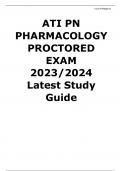
-
ATI PN PHARMACOLOGY PROCTORED EXAM 2023/2024 Latest Study Guide
- Exam (elaborations) • 137 pages • 2023
-
Available in package deal
-
- $18.99
- 41x sold
- + learn more
ATI PN PHARMACOLOGY PROCTORED EXAM A nurse is administering subcutaneous heparin to a client who is at risk for deep vein thrombosis. Which of the following actions should the nurse take? 1. Administer the medication into the client's abdomen. 2. Inject the medication into a muscle. 3. Massage the site after administering the medication. 4. Use a 22-gauge needle to administer the medication. A nurse is providing teaching to a client who has a urinary tract infection and new ...
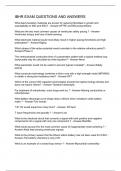
-
IBHR EXAM QUESTIONS AND ANSWERS
- Exam (elaborations) • 17 pages • 2024
-
Available in package deal
-
- $12.49
- + learn more
What lead insulation materials are known for reducing fibroblast in growth and susceptibility to MIO and ESC? - Answer-ePTFE and 80A polyurethane What are the two most common causes of ventricular safety pacing ? - Answer-Ventricular ectopy and loss of atrial sensing What electrode material would most likely result in higher pacing thresholds and high polarization? - Answer-Elgiloy Which phase of the action potential would correlate to the relative refractory period? - Answer-Phase 3 ...

-
IBHRE PREP EXAM STUDY QUESTIONS AND ANSWERS 2024 GRADED A
- Exam (elaborations) • 41 pages • 2024
-
Available in package deal
-
- $13.49
- + learn more
PVARP....after a _____ event, refractory for the ______ - ventricle, atrium what is most likely the cause of the under detection of atrial flutter? - p waves falling into PVAB Which two studies showed that RV pacing in patients could lead to more hospitalizations? - DAVID and MOST when are the wedensky effects the greatest - at narrow pulse widths First degree AV block with symptoms of ppm syndrome is what class of indication for pacing - Class IIa Calculation of the wenkbach inte...
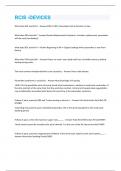
-
RCIS -DEVICES QUESTIONS & ANSWERS SOLVED 100% CORRECT!
- Exam (elaborations) • 10 pages • 2024
- Available in package deal
-
- $7.99
- + learn more
What does EOL stand for? - Answer-END of LIFE= Pacemaker fails to function or dies What does ERI stand for? - Answer-Elective Replacement Indicators= Consider replacement, pacemaker will die soon (low battery) what does BOL stand for? - Answer-Beginning of life = Original settings when pacemaker is new from factory What does POR stand for? - Answer-Power on reset= near death with loss of volatile memory, default backup pacing starts. The most common bradyarrhythmia's are caused by: - Ans...
![ALS/ACLS - Red Cross Final Exam [2022/2023] Graded A+](/docpics/6431b58914216_2570379.jpg)
-
ALS/ACLS - Red Cross Final Exam [2022/2023] Graded A+
- Exam (elaborations) • 12 pages • 2023
-
Available in package deal
-
- $9.99
- 2x sold
- + learn more
ALS/ACLS - Red Cross Final Exam [2022/2023] Graded A+ The resuscitation team suspects that hyperkalemia is the cause of cardiac arrest in a patient brought to the emergency department. Which finding on a 12-lead ECG would confirm this suspicion? Wide-complex ventricular rhythm or tall, pointed T waves A patient with dyspnea and a change in mental status arrives at the emergency department. The healthcare team completes the necessary assessments and begins to care for the patient, including ini...

-
IBHRE Exam Questions and Answers 2024 Graded A
- Exam (elaborations) • 18 pages • 2024
-
Available in package deal
-
- $11.49
- + learn more
Name three causes of atrial standstill Myocardial Infarction Digitalis glycosides Hyperkalemia A 59 yo female with ischemic cardiomyopathy presents with palpitations, lightheadedness, insomnia and feels jittery. She has a CRT-D device. Takes Furosemide, potassium, lisinopril, carvedilol and amiodarone. Seeing short runs of VT on her device interrogation. Hyperthyroidism What would be your best next step for ordering tests? Thyroid panel Which antiarrhythmic drug is least likely to inc...

That summary you just bought made someone very happy. Also get paid weekly? Sell your study resources on Stuvia! Discover all about earning on Stuvia


